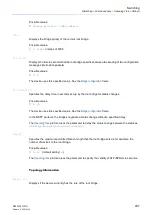
Switching
[ Switching > L2-Redundancy > Spanning Tree > Port ]
209
RM GUI GRS
Release
8.0
09/2019
5.9.2.2 Spanning Tree Port
[ Switching > L2-Redundancy > Spanning Tree > Port ]
In this dialog, you activate the Spanning Tree function on the ports, specify edge ports, and specify
the settings for various protection functions.
The dialog contains the following tabs:
[
CIST
]
In this tab, you have the option to activate the Spanning Tree function on the ports individually,
specify the settings for edge ports, and view the current values. The abbreviation CIST stands for
Common and Internal Spanning Tree.
Note:
Deactivate the
Spanning Tree
function on the ports that are participating in other Layer 2
redundancy protocols. Otherwise, it is possible that the redundancy protocols operate differently
than intended. This can cause loops.
Table
Port
Displays the port number.
STP active
Activates/deactivates the Spanning Tree function on the port.
Possible values:
marked
(default setting)
unmarked
If the
Spanning Tree
function is enabled in the device and disabled on the port, then the port does
not send STP-BPDUs and drops any STP-BPDUs received.
Port state
Displays the transmission status of the port.
Possible values:
discarding
The port is blocked and forwards only STP-BPDUs.
learning
The port is blocked, but it learns the MAC addresses of received data packets.
forwarding
The port forwards data packets.
disabled
The port is inactive. See the
Basic Settings > Port
dialog,
Configuration
tab.
Summary of Contents for GREYHOUND GRS1020
Page 8: ......
Page 16: ......
Page 146: ......
Page 232: ......
Page 310: ......
Page 330: ......
Page 338: ...Readers Comments 337 RM GUI GRS Release 8 0 09 2019 ...
Page 339: ......
Page 340: ......
Page 350: ......
Page 354: ......
Page 617: ...Readers Comments 277 UM Config GRS Release 8 0 09 2019 ...
Page 618: ......
Page 619: ......
















































